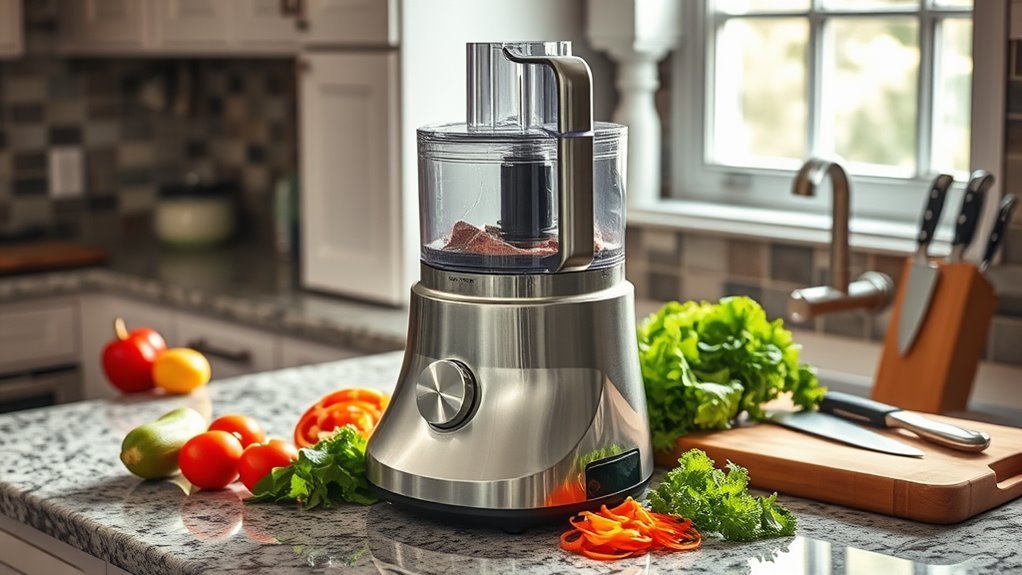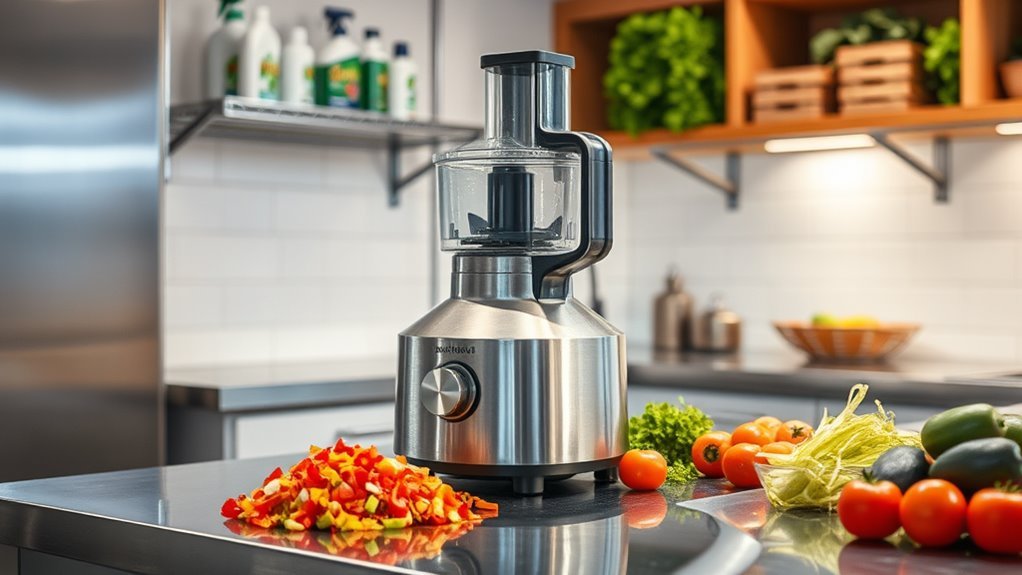Revolutionize your kitchen with a commercial food processor, a versatile powerhouse perfect for extensive culinary tasks. Evaluate your space and workload demands to guarantee flawless integration. Key features like robust motor power and diverse blades will boost efficiency and creativity. Weigh investment benefits against frequency and task versatility to maximize culinary potential. Prioritize maintenance and space considerations to sustain performance. Discover how this investment can transform your cooking experience and reveal new culinary horizons.
Key Takeaways
- Assess kitchen space and ensure the processor fits without disrupting workflow.
- Evaluate the frequency of use to justify the investment in a commercial model.
- Consider the processor’s versatility and ability to handle diverse culinary tasks.
- Compare the cost and efficiency gains against a home processor for your needs.
- Determine if the processor’s capacity matches your typical food preparation volume.
Understanding the Capabilities of a Commercial Food Processor

When diving into the world of commercial food processors, it’s crucial to grasp their extensive capabilities, transforming how you tackle culinary tasks. You’ll discover an array of types of processors, each designed to elevate your culinary artistry.
Whether you’re crafting silky purées, chopping vegetables with precision, or kneading dough to perfection, these machines provide freedom to experiment in the kitchen.
Consider batch bowl processors for volume-based tasks, continuous feed processors for endless chopping, or the versatile buffalo choppers for heavy-duty grinding. Each type has unique usage scenarios, letting you streamline operations and increase productivity.
Embrace the power of commercial-grade efficiency, and you’ll find yourself liberated from the mundane, embracing a new world of culinary possibilities with every pulse and grind.
Evaluating Your Kitchen’s Needs and Workload
Before you invest in a commercial food processor, assess your kitchen’s spatial constraints and make certain it accommodates the necessary footprint without cramping your culinary flow.
Consider the processing volume capacity you require, matching the machine’s output with your typical workload to prevent bottlenecks in your prep station.
Finally, evaluate the task versatility you need, making sure the processor can handle everything from fine juliennes to robust dough blending, enhancing your kitchen’s efficiency and creativity.
Kitchen Space Requirements
A well-organized kitchen is the heart of culinary efficiency, and understanding your kitchen space requirements is essential for integrating a commercial food processor seamlessly.
Begin by evaluating your kitchen layout to determine where this powerhouse appliance fits best. You’ll want it to be accessible, without disrupting your workflow. Consider existing counter space, ensuring it can accommodate the processor’s dimensions while still allowing room for prep and cooking tasks.
Don’t overlook storage solutions; a commercial food processor comes with various attachments that need designated storage.
Assess your cabinets and shelves to identify areas for these components, ensuring easy reach when creativity strikes. By making thoughtful adjustments, you’ll maximize efficiency and cultivate a kitchen that inspires culinary exploration and unrestricted creativity.
Processing Volume Capacity
Understanding your kitchen’s processing volume capacity is vital for optimizing efficiency and meeting culinary demands. If you’re juggling high volumes, a commercial food processor can be a game-changer.
Analyze your typical batch sizes; if you’re frequently processing large quantities, a machine with substantial capacity and rapid processing speed is critical. This guarantees consistency and reduces prep time, allowing your creativity to flourish unfettered.
Consider the processing speed—how fast can it handle your ingredients without compromising quality? A machine that adequately matches your workload will streamline operations, freeing you from unnecessary bottlenecks.
Task Versatility Needs
When considering a commercial food processor for your kitchen, it’s crucial to evaluate the task versatility needs to match your culinary workload. A thorough workload assessment allows you to embrace culinary freedom with task flexibility. Does your kitchen demand seamless shifts from slicing to dicing, or from kneading to pureeing? The right food processor can be your sous-chef, adapting to every culinary whim. Imagine the possibilities:
| Task | Culinary Freedom |
|---|---|
| Slicing Vegetables | Perfectly uniform cuts |
| Kneading Dough | Effortless bread making |
| Pureeing Sauces | Silky smooth textures |
| Grating Cheese | Consistent, even shreds |
Recognize your kitchen’s unique demands and harness a processor that amplifies your creative prowess. It’s about freeing your time to focus on the artistry, not the minutiae.
Key Features to Look for in a Commercial Model
When choosing a commercial food processor, you’ll want to prioritize motor power and capacity to guarantee it can handle high-volume tasks with efficiency and precision.
Opt for a robust motor that delivers consistent torque, paired with a generous bowl capacity to accommodate large batches effortlessly.
Additionally, explore diverse blade types and options to maximize versatility, allowing you to execute everything from fine slicing to robust chopping with culinary finesse.
Motor Power and Capacity
While selecting a commercial food processor, motor power and capacity stand out as essential considerations. You need power efficiency to handle large volumes without compromising performance. Opt for models with robust motor types, such as induction or universal motors, which guarantee consistent torque and durability. A powerful motor, typically ranging from 600 to 1200 watts, lets you master any culinary challenge with ease.
| Motor Type | Power Range (Watts) | Capacity (Liters) |
|---|---|---|
| Induction | 600 – 1200 | 3 – 4.5 |
| Universal | 800 – 1500 | 4 – 6 |
| Brushless DC | 1000 – 1800 | 5 – 8 |
| Asynchronous | 1200 – 2000 | 6 – 10 |
| Synchronous | 1500 – 2200 | 8 – 12 |
Choosing the right motor type and capacity empowers you to release your creativity in the kitchen, guaranteeing every creation is a masterpiece.
Blade Types and Options
Selecting the ideal blade types and options is essential for optimizing your commercial food processor’s performance. With a variety of blade materials and shapes available, you can enhance your culinary creations with precision and flair.
Stainless steel blades offer durability and resistance to corrosion, ensuring longevity in a bustling kitchen. Consider the blade shapes: S-blades are perfect for chopping and mixing, while disc blades excel at slicing and shredding.
Explore these options to suit your culinary ventures:
- Stainless steel S-blades: Perfect for versatile chopping tasks.
- Julienne disc blades: Create uniform strips of vegetables effortlessly.
- Dough blades: Designed for kneading dough with ease.
Choose the right combination, and reveal the potential of your kitchen, creating dishes that tantalize the senses and embody culinary freedom.
Comparing Costs: Commercial vs. Home Food Processors
Though the allure of a commercial food processor might tempt the culinary enthusiast, understanding the cost implications between commercial and home models is essential.
Commercial units, with their robust motors and larger capacities, promise efficiency and speed, but often come with a hefty price tag. When considering cost efficiency, weigh how frequently you’ll use it against your budget considerations. A home food processor can meet everyday needs without breaking the bank, offering a balance between performance and expenditure.
However, if you’re cooking for large gatherings or initiating ambitious culinary projects, investing in a commercial model could be worthwhile.
Evaluate your kitchen’s demands and financial freedom, ensuring the choice aligns with your cooking aspirations. This strategic decision could liberate you to explore culinary creativity without financial constraint.
Maintenance and Durability Considerations

Investing in a commercial food processor requires understanding its maintenance and durability to guarantee long-term value.
With smart care, your culinary powerhouse can withstand the test of time. Here are essential maintenance tips to keep it in prime condition and ensure durability factors are met:
- Regular Cleaning: Disassemble and clean components after each use to prevent residue buildup and maintain peak performance.
- Inspect Wear and Tear: Regularly check blades and motor for signs of wear; replace parts as necessary for seamless operation.
- Lubrication: Apply food-grade lubricant to moving parts to reduce friction and extend the processor’s lifespan.
Space and Storage Requirements
When considering the space and storage requirements for a commercial food processor, it’s crucial to evaluate your kitchen’s layout and available counter space.
You’ll want to make certain that this culinary powerhouse fits seamlessly into your work environment without compromising efficiency. To achieve this, assess your kitchen layout meticulously. Identify prime real estate on your counter for easy access during food prep.
Ensure your culinary powerhouse fits seamlessly into your kitchen without sacrificing efficiency.
As for storage solutions, think vertically—shelves or dedicated cabinets can house your processor and its attachments when not in use.
Consider mobile storage carts to maximize flexibility and freedom of movement. By thoughtfully integrating these elements, you’ll create a dynamic space where culinary creativity knows no bounds, and your commercial food processor becomes an invaluable ally in your culinary adventures.
Making the Decision: Is It Worth the Investment?
How do you determine if investing in a commercial food processor is the right move for your kitchen? Explore an investment analysis to weigh its cost benefit.
Consider how often you whip up culinary masterpieces and the efficiency gains a commercial-grade processor can introduce.
- Time Savings: A commercial processor reduces prep time, letting you focus on creativity, not chopping.
- Durability: Built for heavy-duty use, it withstands rigorous demands, making it a long-term investment.
- Versatility: With various attachments, it handles everything from slicing to kneading.
Freedom in the kitchen means having tools that enhance your culinary prowess.
If your culinary exploits demand speed and precision, the investment could transform not just your kitchen, but your cooking experience.
Conclusion
Deciding on a commercial food processor is like choosing the right sous chef for your kitchen symphony. Evaluate your culinary crescendo: do your recipes demand a workhorse or a nimble assistant? With robust motors and precision blades, commercial models slice through tasks with finesse. Weigh costs against your gastronomic ambitions, considering maintenance and space like seasoning in a dish. If efficiency and durability are your kitchen’s heartbeat, investing in a commercial processor could be your perfect crescendo.